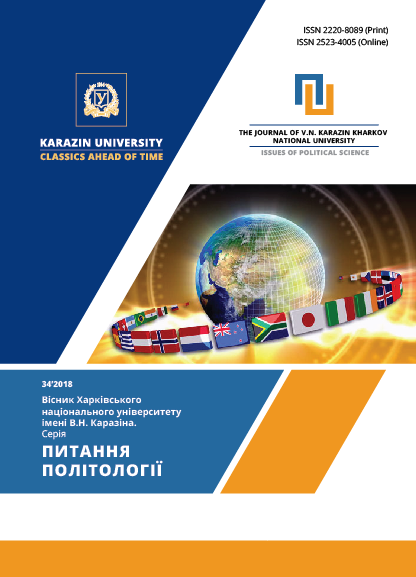ПРАНКІНГ ЯК СПЕЦИФІЧНА ФОРМА ПОЛІТИЧНОЇ КОМУНІКАЦІЇ
Анотація
Розглядається феномен пранкінгу як специфічної форми політичної комунікації. Простежується еволюція та етапи розвитку цього явища починаючи з кінця ХІХ століття, коли зʼявилися телефони. Акцентується на тому, що саме двостадійна побудова моделі пранкінгу сприяє його укоріненню у політичній культурі суспільства. Виявляється певний звʼязок розвитку пранкінгу з досягненнями науково-технічного прогресу у сфері засобів масової інформації. Показано, як з появою Інтернету відбувається перетворення пранкінгу на важливий сегмент сфери соціальних комунікацій, а пранкерства – чи не на окрему професію, як розширюється коло «жертв» пранкерства за рахунок відомих політичних діячів і лідерів певних держав, що своєю чергою впливає на формування суспільної думки щодо цих обʼєктів пранкерства.
Відзначається, що результатом розвитку пранкінгу є ускладнення та урізноманітнення циркуляції політичної інформації між різними елементами політичної системи, між політичною та соціальною системами, між керованими та керуючими, а також між політично активними і пасивними прошарками населення. Для ілюстрації пропонується схематична структура пранкінгу. Робиться висновок про необхідність зосередження уваги політологів та інших науковців на вивченні цього феномена, виявленні позитивних і негативних аспектів явища. Актуалізується проблема наслідків пранкінгу як з точки зору розвитку політичної комунікації, режиму функціонування політичної системи країни загалом та її окремих частин, так і з точки зору внутрішньої та зовнішньої безпеки держави. Ставиться питання про те, які висновки мають зробити самі політичні лідери, аби не попасти на гачок пранкерів та не знизити електоральний рейтинг серед населення своєї країни.
Завантаження
Посилання
Акайомова, А. 2011. “Політична комунікація як процес взаємодії політичних субʼєктівˮ, Політичний менеджмент 1: 87-91.
Лиллекер, Д. 2010. Политическая коммуникация. Ключевые концепты ; пер. с англ. С.И. Остнек. Х.: Изд-во «Гуманитарный центр».
Вован и Лексус. 2018. По ком звонит телефон. СПб.: Питер.
Огаренко, Е.С. 2013. Политические коммуникации: учебно-методическое пособие: Одесск. нац. ун-т имени И.И. Мечникова.
Покровский, А.Н. 2014. “Некоторые аспекты проблемы идентичности в условиях современного коммуникативного пространст-ваˮ, Вісник ХНУ імені В.Н. Каразіна. Серія «Теорія культури і філософія науки». № 1142: 112-118.
Авксентьєва, Т.Г. 2013. Політика і влада в інформаційну епоху: український контекст. моногр. Х.: ХНУ імені В.Н.Каразіна.
Авторські права та ліцензування.
Ліцензійні умови: автори зберігають авторське право, а також надають право журналу публікувати оригінальні наукові статті, що містять результати досліджень і не знаходяться на розгляді для опублікування в інших віданнях. Всі матеріали поширюється на умовах ліцензії Creative Commons Attribution License International CC-BY, яка дозволяє іншим розповсюджувати роботу з визнанням авторства цієї роботи і першої публікації в цьому журналі.
Якщо стаття прийнята до друку в журналі "Вісник Харківського національного університету імені В.Н. Каразіна. Серія "Питання політології", автор має підписати угоду про передачу авторських прав. Угода надсилається на поштову (оригінал) або електронну адресу (сканована копія) Редакції журналу.
Цією угодою автор засвідчує, що поданий матеріал:
- не порушує авторських прав інших осіб або організацій;
- не був опублікований раніше у інших видавництвах та не був поданий до публікації у інші видання.
Автор передає редколегії права на:
- публікацію статті українською (англійською) мовою та розповсюдження її друкованої версії;
- переклад статті англійською мовою (для статей українською мовою) та розповсюдження друкованої версії перекладу;
- розповсюдження електронної версії статті, а також електронної версії англомовного перекладу статті (для статей українською та російською мовою), через будь-які електронні засоби (розміщення на офіційному web-сайті журналу, в електронних базах даних, репозитаріях тощо).
Автор зберігає за собою право без узгодження з редколегією та засновниками:
- Використовувати матеріали статті повністю або частково з освітньою метою.
- Використовувати матеріали статті повністю або частково для написання власних дисертацій.
- Використовувати матеріали статті для підготовки тез, доповідей конференцій, а також усних презентацій.
- Розміщувати електронні копії статті (у тому числі кінцеву електронну версію, завантажену з офіційного web-сайту журналу) на:
- персональних web-ресурсах усіх авторів (web-сайти, web-сторінки, блоги тощо);
- web-ресурсах установ, де працюють автори (включно з електронними інституційними репозитаріями);
- некомерційних web-ресурсах відкритого доступу (наприклад, arXiv.org).




